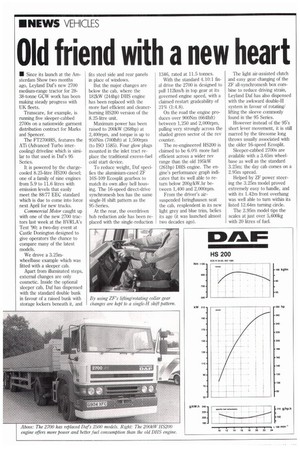Old friend with a new heart
Page 12

If you've noticed an error in this article please click here to report it so we can fix it.
• Since its launch at the Amsterdam Show two months ago, Leyland Daf's new 2700 medium-range tractor for 2838-tonne GCW work has been making steady progress with UK fleets.
Transcare, for example, is running five sleeper-cabbed 2700s on a nationwide garment distribution contract for Marks and Spencer.
The FF2700HS, features the ATi (Advanced Turbo intercooling) driveline which is similar to that used in Dafs 95 Series.
It is powered by the chargecooled 8.25-litre HS200 diesel; one of a family of nine engines from 5.9 to 11.6 litres with emission levels that easily meet the 88/77 EEC standard which is due to come into force next April for new trucks.
Commercial Motor caught up with one of the new 2700 tractors last week at the BVRLA's Test '90; a two-day event at Castle Donington designed to give operators.the chance to compare many of the latest models.
We drove a 3.25m
wheelbase example which was fitted with a sleeper cab. Apart from illuminated steps, external changes are only cosmetic. Inside the optional sleeper cab, Daf has dispensed with the standard double bunk in favour of a raised bunk with storage lockers beneath it, and
fits steel side and rear panels in place of windows.
But the major changes are below the cab, where the 182kW (244hp) DHS engine has been replaced with the more fuel efficient and cleanerburning HS200 version of the 8.25-litre unit.
Maximum power has been raised to 200kW (268hp) at 2,400rpm, and torque is up to 95ONm (7001bft) at 1,500rpm (to ISO 1585). Four glow plugs mounted in the inlet tract replace the traditional excess-fuel cold start device.
To reduce weight, Daf spedfies the aluminium-cased ZF 16S-109 Ecosplit gearbox to match its own alloy bell housing. The 16-speed direct-drive synchromesh box has the same single-H shift pattern as the 95-Series.
At the rear, the overdriven hub reduction axle has been replaced with the single-reduction 1346, rated at 11.5 tonnes.
With the standard 4.10:1 final drive the 2700 is designed to pull 112km/h in top gear at its governed engine speed, with a claimed restart gradeability of 21% (1:4.8).
On the road the engine produces over 900Nm (664Ibft) between 1,250 and 2,000rpm, pulling very strongly across the shaded green sector of the rev counter.
The re-engineered HS200 is claimed to be 6.0% more fuel efficient across a wider rev range than the old 195kW (261hp) DHS engine. The engine's performance graph indicates that its well able to return below 200g/kW.hr between 1,400 and 2,000rpm.
From the driver's airsuspended Isringhausen seat the cab, resplendent in its new light grey and blue trim, belies its age (it was launched almost two decades ago).
The light air-assisted clutch and easy gear changing of the ZF all-synchromesh box combine to reduce driving strain, Leyland Daf has also dispensed with the awkward double-II system in favour of rotating/ lifting the sleeve commonly found in the 95 Series.
However instead of the 95's short lever movement, it is still marred by the tiresome long throws usually associated with the older 16-speed Ecosplit.
Sleeper-cabbed 2700s are available with a 3.65m wheelbase as well as the standard 3.25m; the day cab comes on a 2.95m spread.
Helped by ZF power steering the 3.25m model proved extremely easy to handle, and with its 1.42m front overhang was well able to turn within its listed 12.64m turning circle.
The 2.95m model tips the scales at just over 5,600kg with 20 litres of fuel.




































































































